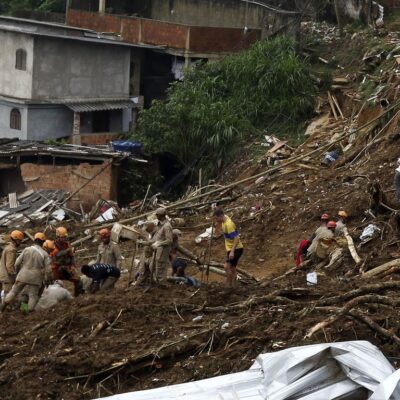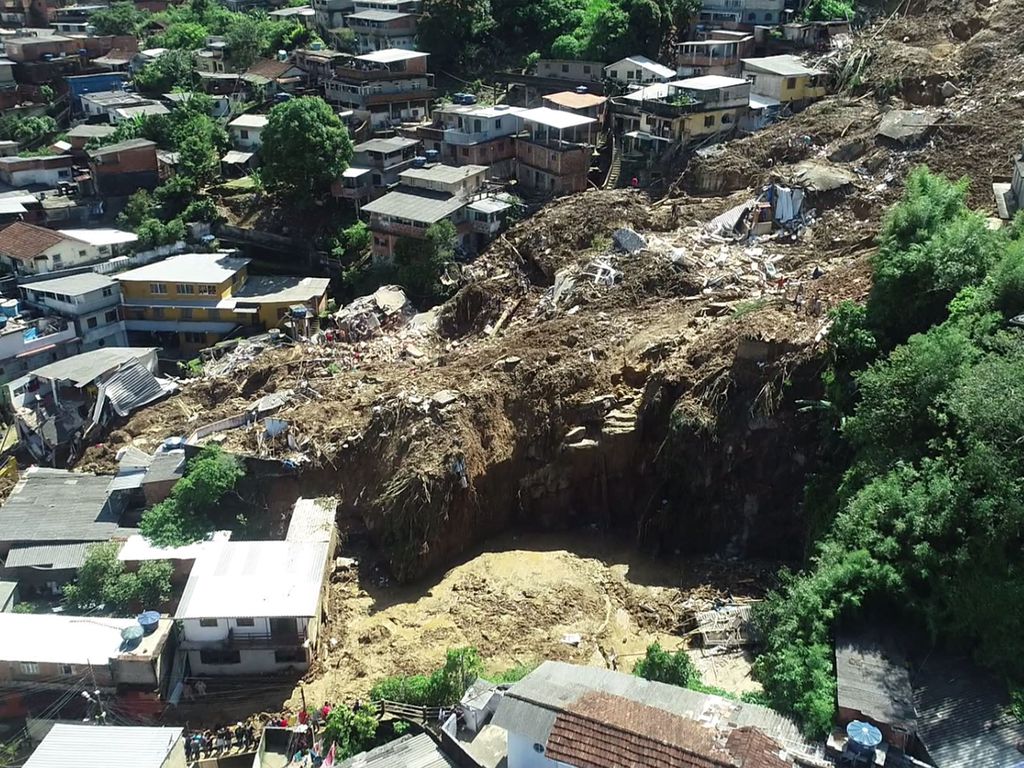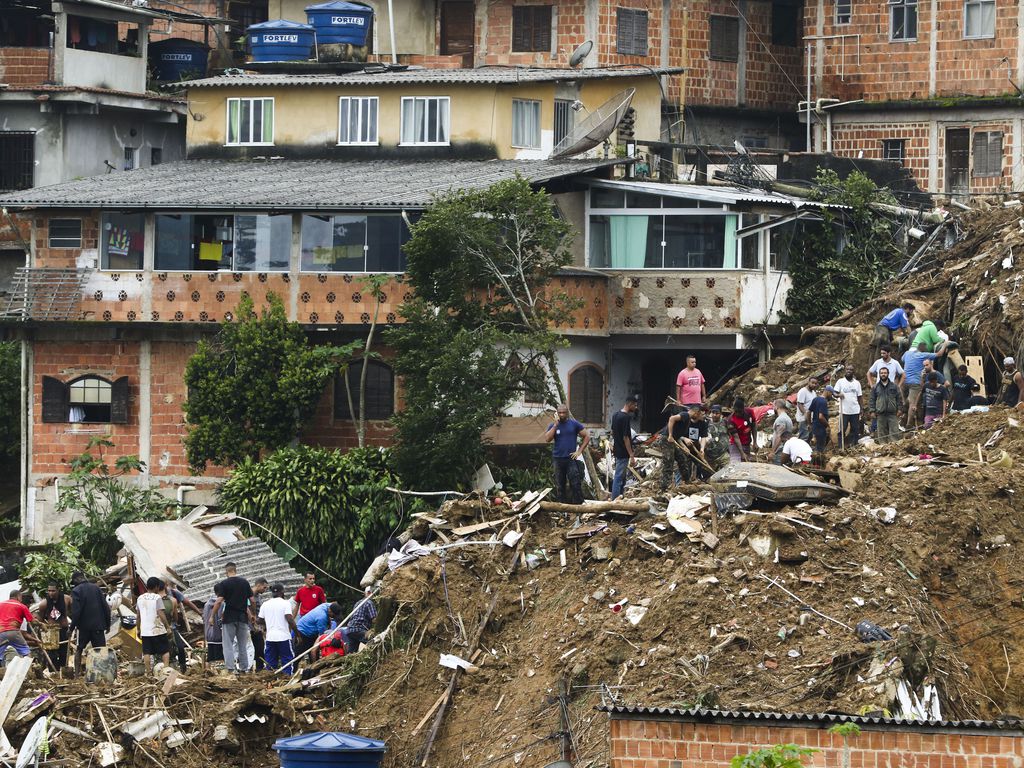21/02/2022 18:40
Aercio B. de Oliveira e Bruno França*

Fire Brigade, Residents and Volunteers at Morro da Oficina. Photo: Tânia Rego / Agência Brasil
Morro do Bumba, at Niterói, 2010; Mountain Region of Rio de Janeiro, 2011; Xerém, at Duque de Caxias, 2013; Petrópolis, 2022, just to quote some of the most tragic environmental disasters in the last decades. The lives and dreams lost to floods and landslides are countless.
Devastated and counting its dead, today’s Petrópolis demonstrates the most perverse face resulting of old and new issues which affect us and will increasingly keep leaving its track of pain and mud.
There is no surprise in the episode, which took place at this city in the last February 15th, and unfortunately – while causes and aggravating are not seriously handled – it will not be the last. Far from a mainly ‘natural’ issue related exclusively to the region’s climate and terrain factors, disasters resulting from rain are the consequences of increased social inequalities, lack of public investments in urban infrastructure, noncompliance with legislation, and states contempt for the adoption of measures to face climate change. Because of such omission, Brazilian cities soil use and occupation are highly affected, specifically in regions with high population density, as is the case of our 15 major cities, where around 40% of the population are located, almost 80 million people, according to Instituto Brasileiro de Geografia e Estatística (IBGE).
The effects of these omissions are terrifying. For centuries, there have been no appropriate and required policies for urban growth, resulting in an inadequate management of rainwater drainage system, of sewage treatment, of solid waste disposal, of wellsprings preservation, of rivers and creeks dredging, of riverbanks and slopes vegetation preservation, and so on.

Aerial image of slide down hills. Photo: TV Brasil
The state of Rio de Janeiro, specifically in Metropolitan Zones – considering natural and social issues – brings together all the elements to increase the risks caused by extreme weather events. With the second greater density population in the country, around 17 million people squeeze through 49,000 km². Most of this population inhabit areas at risk of flooding, close to rivers, streams, and slopes at risk of landslides. According to Centro Nacional de Monitoramento e Alertas de Desastres Naturais (CEMADEN) and IBGE data, at the state of Rio de Janeiro, the percentage of population living at risk areas reaches 10%. Only in this city capital, there are almost 500,000 people living under these conditions.
The distribution of environmental risks according to social class is a ‘common’ consequence of capitalism – immediately linked to social and environmental issues. As a result, the victims of these environmental disasters are black people from the poorest sectors of society, who cannot afford adequate accommodations – not exposed to risks, and have to live in these areas to guarantee a minimal access to urban goods and services.
The marginalization among those populations – certainly not a personal choice – has developed along the historic relationship between capital and work in an increasingly predatory capitalism of an ultraneoliberal state, marking production and reproduction in our cities. Inequities and environmental racism worsen as a result, showing us that Brazilian urban pattern is not a fatality.
Removing is Not a Public Policy
We cannot accept that cases like this of Petrópolis justify a new period of haphazard actions removing people from slums and popular housing areas. From times to times along our history, ‘public authorities’ come with new and old arguments to validate these removals – for the most of twentieth century the excuse was sanitary, in recent decades, it’s the ‘environmental risk’.

Fire Brigade, Residents and Volunteers working at Morro da Oficina hillslides. Photo: Tânia Rego / Agência Brasil
The governor Claudio Castro (PL) first speech – after this recent disaster – elucidates this discussion: “[…] it will be no easy task to remove people from these sites, but we certainly will. […] No matter how painful that may be to some.” This is the usual speech against underprivileged. There is no doubt that in certain situations removing families from such areas inappropriate for living and at death risk is mandatory, although we cannot accept such planned episodes, in which families are moved to sites far from their workplace, lacked urban infrastructure, far from public goods and services, diminishing neighborhood networks.
If natural and social causes of environmental disasters are old and well known – as well as predictable and preventable –, the new issues related to this process are directly linked to climate change impacts and its legacy towards a tragic future. The governor Claudio Castro speech indicates those rains – responsible for turning Petrópolis city into a river – were just an extraordinary event, the analysis about global warming consequences indicates the opposite – these events will be less exceptional over times.
The exposure of this metropolitan area of Rio de Janeiro to extreme events, like frequent heavy rainfall and hydric stress is imminent. Because of its location at a weather front – squeezed between the hill and the sea –, the state of Rio de Janeiro frequently suffers heavy precipitation. At the same time, polluting industries under no supervision dispose their untreated effluents into rivers and wellsprings, raising pollution degree into groundwater and surface water.
Paraíba do Sul River also presents an emblematic and serious situation, being the main source of water supply for 70% of metropolitan zone population. Paraíba do Sul suffers the impacts of companies’ pollution in its surroundings, as well as silting due to the lack of maintenance in its channel and slopes and due to the untreated sewage disposal, besides the drought resulting of changes in hydrological cycle. This context of environmental degradation increases the risks and places Rio de Janeiro as one of the states with greater hydric stress.
Whatever the problem is – excess or lack of water – social movements and organizations must connect their mobilization and urban infrastructure agendas – housing, sanitation, land title regularization, mobility, among others – to climate change and radical adaptations measures. There is a number of proposals, experiences, and popular, traditional and scientific knowledge, which should be included in public policies of climate adaptation. They range from rivers macro-drainage – similar to the one conducted at the beginning of last decade in Iguaçu watershed at Baixada Fluminense, where FASE RJ was responsible for coordinating social and environmental technical work – to urban agriculture, in order to address starvation and increase urban soil permeability, reducing heat islands and floods.
The tragedy in Petrópolis cannot serve only to corporate media interests, turning pain into a show and a stage for ambitious politicians.
As the families of missing victims are digging under tons of mud and debris, we must also use the available resources to dig with our own hands. Maybe we can find a state minimally aware of what a great part of the population needs. A population whose desire is to live, reversing the current periodization logic, which kills black people, underprivileged, slum and periphery dwellers.
*Aercio B. de Oliveira is National Advisor and FASE Coordinator in Rio de Janeiro. Bruno França is FASE Teacher in Rio de Janeiro.










